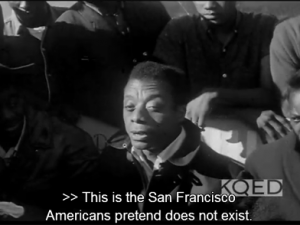The Bay Area TV Archive operates out of a few rooms in the back of the San Francisco State library. None of the equipment that crowds Cherian's small office looks very high tech, and a majority of it isn't. His most-used tool is a film rewind table: two reels and a hand crank.
The first step to recovering any film is to spin it on the rewind table from one reel to the other, hand-cleaning and repairing it frame by agonizing frame.
“Often it is very, very dull and repetitive,” Cherian says.“The payoff has to be worth it if you're going to get involved in this business.”
When I ask Cherian what payoff he's hoping for now, he says he's looking for the last interview Robert Kennedy gave before he was assassinated.
Cherian secured federal funding for his archive three years ago, in part because he was putting the recovered film online, making it public. The clips run the gamut, from arts material like this interview with Janis Joplin and Big Brother & The Holding Company to news footage like this clip of protesters and police clashing on the San Francisco State campus to a report on the assassinations of Harvey Milk and Mayor Moscone.
Since he started uploading the footage, interested parties contact Cherian daily. They want to add historical context to the clips or correct some fact he's got wrong, or ask to see more. The public nature of the project is what compelled Dave Peoples to call Cherian about the film that was decomposing in his storage facility.
Cherian says most of the local programming in the Bay Area from the 1950s is gone, along with about 40 percent from the ‘60s and ‘70s. The ‘80s are even worse -- a black hole, he says. That's when stations used a type of tape that degrades quickly. But even today, long after stations started preserving their material, many lack easily searchable databases or digital backups.
Peoples, the ex-editor, has a fetish for film, which he's worked with most of his life, cutting for both newscasts and features. In his dark, dank storage facility in Berkeley, there are reels everywhere, some in corroding metal cans and other bits lying in the open.
The Golden Age of News Footage
Peoples gets wistful as he reminisces about the old days at KRON-4. Unlike today, Bay Area TV stations in the ‘60s used to send out large teams of camera and sound personnel along with reporters; they captured footage of the Black Panther movement, police violence on Bay Area campuses and the Native American occupation of Alcatraz, among other historic events. Peoples loved that film so much, he couldn't bring himself to toss it, as he was told. Instead, he sneaked it home, squirreling it away for years.
“I didn't have a methodical way of doing it,” he says. “I would just look on the piece of tape we put on the thing and it would say Bobby Seale in Oakland or something and I'd say, oh you can't throw out Bobby Seale in Oakland, that's history, right?”
Back in his office, Alex Cherian plays that clip of Seale. It's 1968 and Supreme Court Justice Thurgood Marshall has just denied bail to fellow Black Panther leader Eldridge Cleaver.
“Black People are not making any progress,” Seale says. “The revolutionary struggle should go on forth. Thurgood Marshall, as far as I'm concerned, his ass belongs to black people, his ass belongs to black people.” Then you can hear a reporter telling the cameraman to cut.
Peoples only saved about 10 hours of film, mostly civil rights and protest footage. Cherian has cleaned up and edited some of the material, but the rest sits in a box on the archive shelves, an unfinished project. The Bay Area TV Archive is mostly a one-person operation, and Cherian says without a staff, he just doesn't have the ability to go through it all, about 4,000 hours from local stations KTVU, KPIX, KRON-4, and KQED, among other sources. Even though he's been at it for three years, Cherian has only been able to put about 4 percent of it online. He says “some of the film will be in the wrong can, some will be unlabeled, who knows what we have.”
Because the task is so overwhelming, Cherian works off of leads. When KRON-4 reporter Art Finger told him about the Robert Kennedy interview, he put his other projects on hold. Finger remembered interviewing Kennedy on his charter plane, three days before his assassination. After rifling through the KRON collection for hours, Cherian finally found the right can. As he spun the frames on the rewind system, he saw Kennedy all right, but he couldn't find the plane footage. The film, he discovered, was from the wrong day.
Robert Kennedy's last interview, it turns out, could be anywhere -- unlabeled or in some other can.
Or lost forever.
